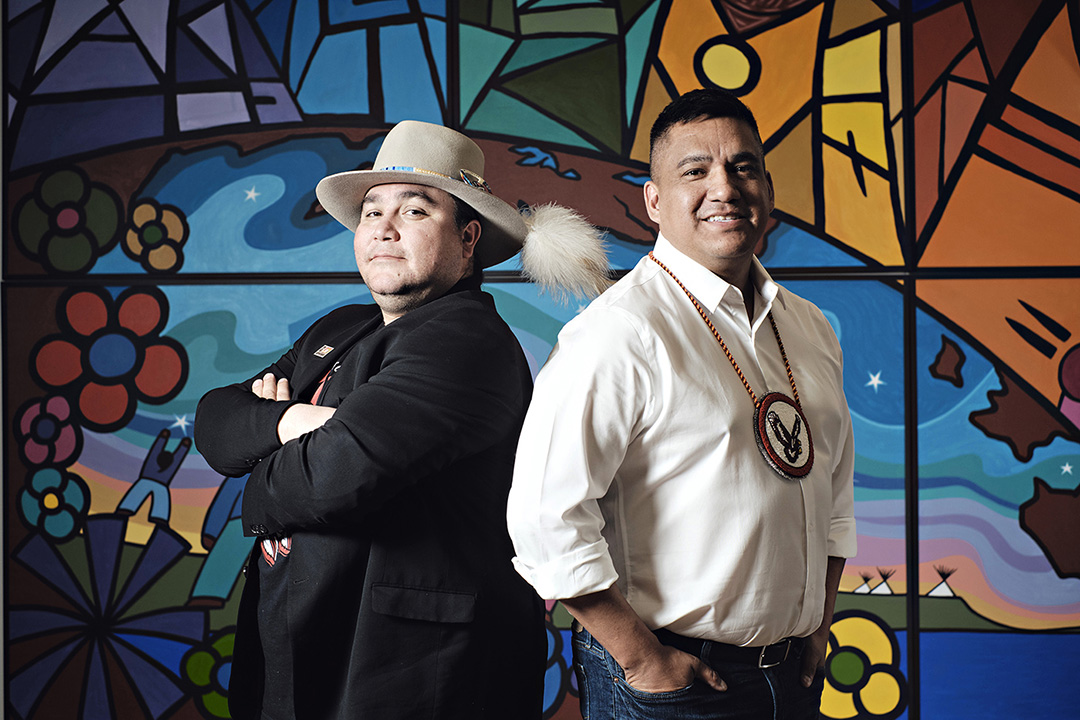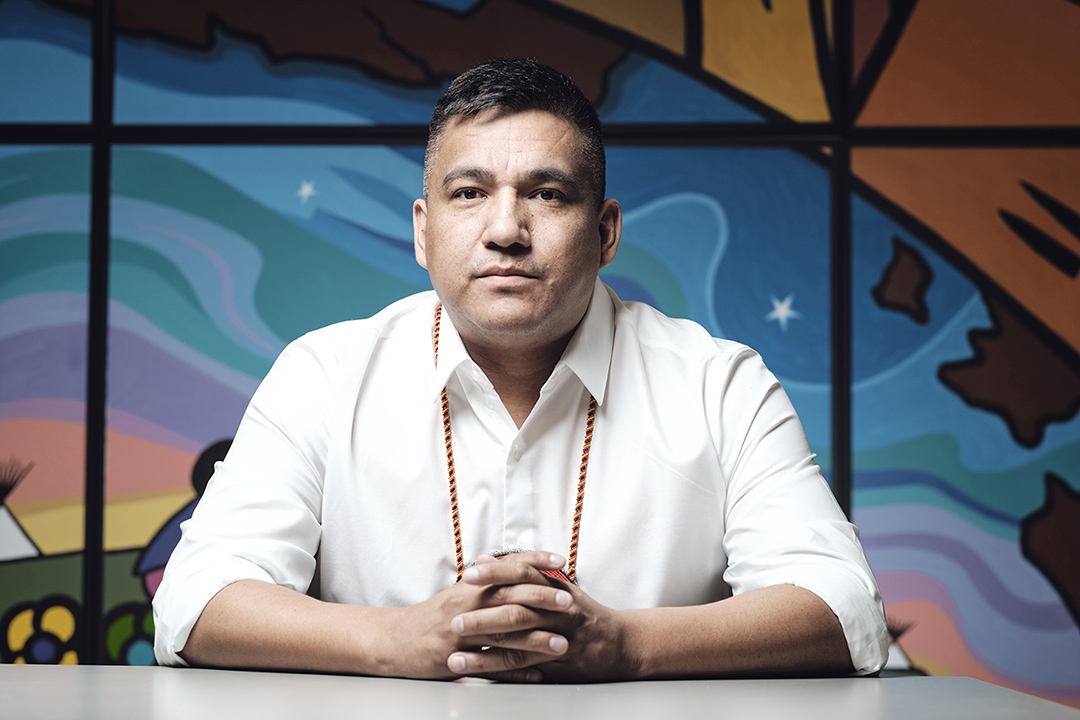Bringing education home
Chief Evan Taypotat (BEd’05) did not become a leader on his home reserve of Kahkewistahaw First Nation by chance.
By CHELSEA LASKOWSKIThe seed was sown decades ago within his family unit, which included extended family, and was nurtured within the schools he attended.
Along the way, he learned how a good education and motivated teachers can build a person up.
That’s why he hopes a new partnership with the University of Saskatchewan will produce leaders and teachers in his community.
On July 13, 2018, a memorandum of understanding was signed between the College of Education, the Indian Teacher Education Program (ITEP) and the Kahkewistahaw First Nation, bringing a four-year bachelor of education curriculum to Kahkewistahaw First Nation, located about 150 kilometres east of Regina.
While Taypotat himself received his education degree on the USask campus, this program is unique in that it brings teachers to the reserve and lets students learn without having to leave their home community. This past fall, the program welcomed its first 15 students.
“I think all 15 of the [students] may have families and children, and it's unrealistic to think that [we] can move 15 people to Saskatoon to be in ITEP. So we told them we are going to bring this program to the First Nation,” he said.
The idea all started with a conversation Taypotat had with his former ITEP classmate Chris Scribe (BEd’05, MEd’12) at a powwow in the summer of 2017.
They tossed the idea around and Taypotat laughed at the concept of bringing home the program he had to move to Saskatoon to study in.
Taypotat recalls what Scribe, a current PhD candidate in educational administration and director of ITEP, said next: “We can do it.”
Fast forward to the fall of 2018, when the two received blessing from the dean of education, Michelle Prytula (BCOMM’92, BEd’95, MEd’04, PhD’08). They all shook hands at a ceremony marking the beginning of classes for Kahkewistahaw’s first on-reserve ITEP students.
Scribe said he presented the opportunity, but gives full credit to Kahkewistahaw for making it happen. He said the benefits of offering the ITEP program on reserve are huge.
“If you were to look at numbers across Canada for First Nations students entering post-secondary, it's within their first or second year they fail. If we can capture them and eliminate the barriers to them being successful, I mean, wicked, that's awesome. And that's what Kahkewistahaw is doing with their students right now,” he said.
While similar programs have been done in communities like Big River First Nation, Onion Lake, Poundmaker and Little Pine before, the Kahkewistahaw program marks the first time ITEP classes have travelled to Treaty 4 territory.
It’s a big deal for a community that both Taypotat and Scribe said struggles with the social impacts of residential schools and colonization, in the form of alcoholism, drug use, violence and high incarceration rates.
Drawing from the past

The meaning of the word Kahkewistahaw is “he who flies around.”
And fly is what the people of Kahkewistahaw First Nation once did, all over the Prairies: they have long lived near present-day Broadview in eastern Saskatchewan, but hunted buffalo as far west as the Cypress Hills until the 1880s.
After signing treaty, the First Nation’s namesake Chief Kā-kīwistāhāw and his people resisted the nearby community’s efforts to surrender some of their reserve land.
Over time, the reason for flying from the reserve changed. Children, without their parents, were sent away to residential schools.
Meanwhile, the parents who stayed behind had their movement and actions restricted by Indian agents. The freedom associated with the First Nation’s name lessened more and more.
Taypotat himself went to Qu’Appelle Indian Residential School at Lebret. Scribe is from another Treaty 4 First Nation called Carry the Kettle, and has closely studied colonial education.
“If we go back to our original learning lodges, before colonization, before settlers came to this land, we had an education system where our children would be educated by our elders, by our grandmothers and our grandfathers,” Scribe said.
It’s no surprise then, that those traditional practices being torn away from children led to a troubled relationship with the education system as Western culture knows it today.
When children attending a residential school would briefly see their parents, the Cree word they used to describe it—kiskinwahamctowikamik—translated to “A building you go to learn to cry,” Scribe said.
“Instead of that kindness, generosity, beauty, understanding, love—all of that was replaced with physical, sexual, emotional abuse by priests and nuns from the various churches. A lot of our people are lost.”
While Chief Kā-kīwistāhāw made clear during the resistance of 1885 that “my and my young men’s fighting days were over,” according to Indian agent Allan Macdonald’s records, Taypotat said he considers himself a modern warrior.
“Our people were warriors—men and women—were warriors for thousands of years. And somewhere along the way, after residential schools and being in contact with Europeans, we lost that way. So I take pride in being a warrior,” Taypotat said.
How to love education again
As a young man, Taypotat went through the Bold Eagle program, which provides military training to Indigenous youth. He later went on to join the military. He was a member of the Canadian Armed Forces for five years, which included a tour of duty in Afghanistan in 2011.
“I had achieved all the goals I wanted to achieve in my military career,” he said. “I saw a lot of good leaders, and I saw some poor leaders as well. So the goal was to learn from all of them, good, poor or great.”
Raised by a single mother, he credits three educators for guiding him on his current path. These three male teachers showed him the power of a strong male role model.
“You miss that male presence in your life. So then when you see that male presence that you respect, and that you yearn for, I think you naturally gravitate towards that,” Taypotat said. “That was my case. I gravitated to the males that I thought understood me, and let me be me, and that let me have fun, and didn't judge me on my skin colour or where I came from.”

Those teachers, all non-Indigenous, bridged any racial gaps that could have existed by just “treating me really fairly,” Taypotat said.
There were echos of those three teachers, who used to face off against Taypotat and a few of his friends to make floor hockey games more challenging, in Taypotat when he went on to become a teacher himself.
After earning his USask degree, returning home to Kahkewistahaw to teach was always his plan. He was in for a challenge when he walked through the doors of the school.
“They gave me the biggest, baddest class you ever did see, so they told me,” he said.
Some of the boys in that Grade 6 class were getting into the gang life and lacked male role models. Taypotat used what he calls "tough love” to change that.
“It took about a month but at the end of it we had about 14 great students that all were there to learn. And some had a few bad days every now and again but we just worked through it together," Taypotat said.
Making school a fun place to come to is a marked departure from First Nations history in education. According to Scribe, the 40-plus years that ITEP has been doing community-based post-secondary is a success story in a system that once had a goal to “kill the Indian in the child” and brought his people to the brink.
This is thanks to collaboration between some of the program’s non-Indigenous pioneers, like current on-reserve ITEP instructor Orest Murawsky (BA’71, BEd’74, MEd’75), and the Indigenous people he teaches. Murawsky was the director of the ITEP program for more than 40 years, and the one who initiated the ITEP community-based programs.
“We're in a space now, thanks to the efforts of a lot of different people, including Murawsky, where Indigenous people can take those leads now, where that wasn't available to us in the past,” Scribe said.
On a January day, Taypotat said he was happy to see Murawsky teaching the Kahkwewistahaw students.
When he sees those students, he sees opportunity—opportunity for better wages for those teachers-to-be, and for students on reserve to get passionate teachers who are invested in their futures.
The history of ITEP
ITEP and SUNTEP are USask education programs that include a focus on learning Indigenous histories and cultures. The ITEP program has been offered on campus since 1972 and ITEP has been offering community-based teacher education programs since 1976. ITEP teachers—more than 1,500 graduates from about 60 First Nations in Saskatchewan, Alberta, Manitoba, Northwest Territories, Quebec and Nunavut—ensure the survival of culture as they are academically and culturally educating the youth of communities throughout Canada.
All photos by Dave Stobbe.

